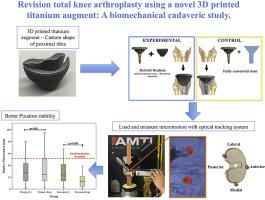Journal of the Mechanical Behavior of Biomedical Materials ( IF 3.9 ) Pub Date : 2020-07-05 , DOI: 10.1016/j.jmbbm.2020.103944 C Dion 1 , G Yamomo 2 , J Howard 1 , M Teeter 2 , R Willing 2 , B Lanting 1

|
Background
During revision total knee arthroplasty (rTKA), proximal tibial bone loss is frequently encountered and can result in a less-stable bone-implant fixation. A 3D printed titanium revision augment that conforms to the irregular shape of the proximal tibia was recently developed. The purpose of this study was to evaluate the fixation stability of rTKA with this augment in comparison to conventional cemented rTKA.
Methods
Primary total knee arthroplasty (pTKA) surgery was performed on 11 pairs of thawed fresh-frozen cadaveric tibias (22 tibias). Fixation stability testing was conducted using a three-stage eccentric loading protocol. Bone-implant micromotion was measured using a high-resolution optical system. The pTKA were removed. Revision TKA was performed using a 3D printed titanium augment or a standard fully cemented stem. The three-stage eccentric loading protocol was repeated and micromotion was measured for the revision implants.
Results
After rTKA, the mean vertical micromotion was 28.1 μm ± (SD) 20.3 μm in the control group and 17.5 μm ± 18.7 μm in the experimental group. There was significantly less micromotion in the experimental group (p = 0.029).
Conclusions
This study suggests that early fixation stability of revision TKA with the novel 3D printed titanium augment is better then the conventional fully cemented rTKA. The early press-fit fixation of the augment is likely sufficient for promoting bony ingrowth of the augment in vivo. Further studies are needed to investigate the long-term in-vivo fixation of the novel 3D printed augment.
中文翻译:

使用新型3D打印的钛增强材料修订全膝关节置换术:一项生物力学尸体研究。
背景
在翻修全膝关节置换术(rTKA)期间,经常会发生胫骨近端骨丢失,并可能导致不稳定的骨植入物固定。最近开发了一种3D打印的钛修订版增强版,它符合胫骨近端的不规则形状。这项研究的目的是评估与传统的胶结rTKA相比,rTKA与这种增强剂的固定稳定性。
方法
对11对解冻的新鲜冷冻尸体胫骨(22个胫骨)进行了一次全膝关节置换术(pTKA)。使用三阶段偏心加载方案进行固定稳定性测试。使用高分辨率光学系统测量了骨植入物的微运动。去除了pTKA。修订版TKA使用3D打印的钛增强材料或标准的全骨水泥杆进行。重复三阶段的偏心加载方案,并测量翻修植入物的微动。
结果
rTKA后,对照组的平均垂直微动为28.1μm±(SD)20.3μm,实验组为17.5μm±18.7μm。实验组的微动明显减少(p = 0.029)。
结论
这项研究表明,用新型3D打印钛增强剂对TKA修订版的早期固定稳定性要好于传统的全胶合rTKA。增强物的早期压入配合固定可能足以在体内促进增强物的骨向内生长。需要进一步的研究来研究新型3D打印增强物的长期体内固定。

























 京公网安备 11010802027423号
京公网安备 11010802027423号